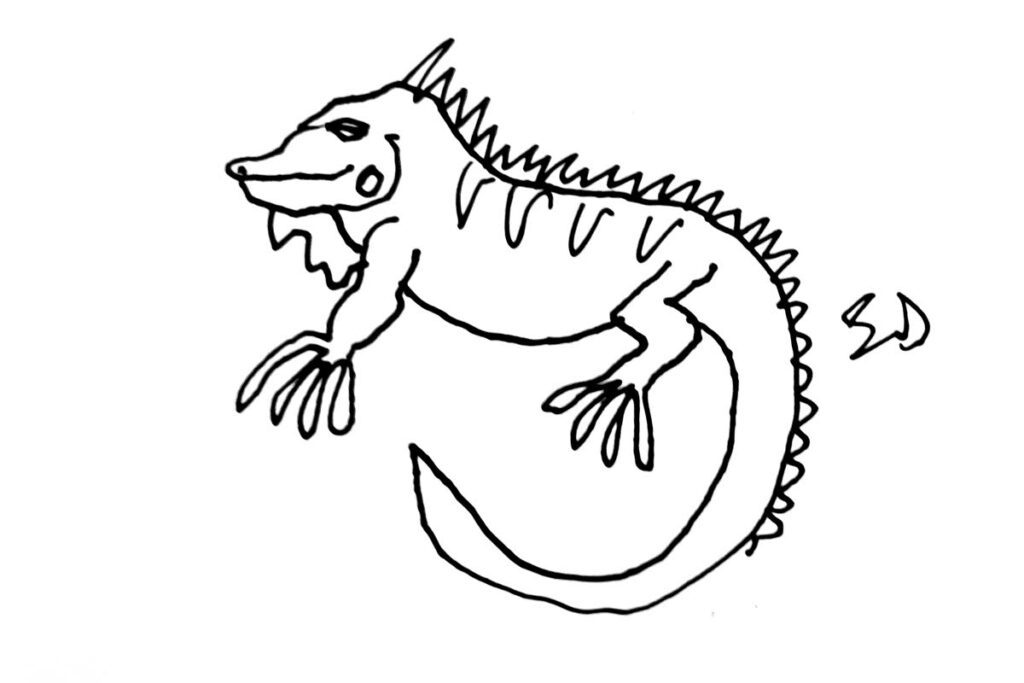Iguanas are not for eating

On Friday last week, as I was driving out to run some errands, a large bright green iguana was sitting on the culvert near my home.
As I stopped to admire him/her, it crossed my mind that I could understand why some people have them as pets.
Ironically, on Monday, a few days later, I got a phone call from Linx, a man I met a few years ago when he sought my help after someone had poisoned his dogs. Since then, Linx, who works at Store Bay beach, sometimes contacts me for animal-related help – an injured bird on the beach, advice on a sick dog, etc.
“An iguana was crossing the road and a man hit it with his car,” Linx said over the phone. “He is injured.”
I told him to hold on, I was coming.
Upon arrival, I found Linx and Collis Thomas (the artist who sells paintings and carvings at the crossroads en route to Crown Point Hotel and Store Bay) standing at a tap in the field near Store Bay, with a young iguana lying in a puddle of water. I want to commend these two gentlemen for not seeing the iguana as food, but as a sentient being in need of assistance on account of his injury.
The fact that they were attempting to keep him cool, had made a call seeking help and stood waiting with him in the hot sun until I arrived speaks volumes.
Many others throughout the nation would have thought of the injured creature with almost rabid intensity, licking their lips at visions of him in their pot. Some, reading this, may even be laughing, considering Linx, Collis and me foolish for not following the culinary path of action.
“He needs some painkillers,” Collis said as I picked him up, body wrapped in a towel (to keep him secure so he would not run around in my vehicle as I drove home).
With the exception of a large iguana that my dogs had once killed and left for me as a gift near the front door, holding “Iggy” was the closest I had ever been to one of these majestic creatures.
Being no expert on reptiles, I phoned Ricardo Meade of El Socorro Centre for Wildlife Conservation for advice.
“He is bleeding from his mouth,” I explained.
“I’m sorry, but there is not much that can be done when that is happening,” Meade said, indicating the obvious – internal injuries. “Euthanasia is best.”
Coincidentally, I was due to meet Dr Gordon (veterinarian) in an hour’s time, so I gave her a quick call to explain the situation. Unfortunately, Iggy did not last that long. I held him, admiring his beautiful features – the tiny spine-like crest running along his back, his hard-to-the-touch, somewhat scaled head, the diamond shapes of his skin, his long, elegant green fingers, which had grown too weak to grasp mine. I could feel his fine ribs under the thin, cool skin.
How on earth could anyone eat this? How much “meat” could they get from his body? I watched as his mouth opened and closed in pain, and as life and colour drained from him, turning his emerald-green body to a muddy brown, stiff corpse.
A friend of mine watched helplessly a few days ago when someone we know and one of his “pardnas” were bent on catching iguanas they had seen in nearby bushes.

This was despite the notice from the Ministry of Agriculture, Land and Fisheries that states: “All hunting and or possession of iguana is prohibited during the months of January, February and March. The fine for which is $10,000. Hunting of the lizard species iguana ends on December 31, 2023. Similarly, hunting of lizards are (sic) not permitted within the municipal boundaries of the city of Port of Spain. (Legal notice No 281 of 2019) and (Regulations (6) (1) (c) and (7) (1A).”
This notice, of course, is easily ignored in a country where laws pertaining to animals are seldom enforced, and policemen are rarely likely to follow up on reports of illegal iguana hunting when they themselves may be keen on eating that meat (as one of them admitted to me when we once discussed hunting).
A message to those who eat iguanas – Let them roam freely. Perhaps it would be wise to follow their example and eat vegetation instead.


Comments
"Iguanas are not for eating"